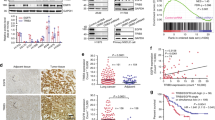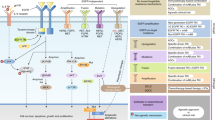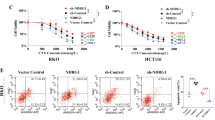Abstract
Epidermal growth factor receptor (EGFR) is a ubiquitously expressed receptor tyrosine kinase involved in the etiology of several human cancers. Cetuximab is an EGFR-blocking antibody that has been approved for the treatment of patients with head and neck squamous cell carcinoma and metastatic colorectal cancer. Previous reports have shown that EGFR translocation to the nucleus is associated with cell proliferation. Here we investigated mechanisms of acquired resistance to cetuximab using a model derived from the non-small cell lung cancer line H226. We demonstrated that cetuximab-resistant cells overexpress HER family ligands including epidermal growth factor (EGF), amphiregulin, heparin-binding EGF and β-cellulin. Overexpression of these ligands is associated with the nuclear translocation of the EGFR and this process was mediated by the Src family kinases (SFK). Treatment of cetuximab-resistant cells with the SFK inhibitor, dasatinib, resulted in loss of nuclear EGFR, increased membrane expression of the EGFR and resensitization to cetuximab. In addition, expression of a nuclear localization sequence-tagged EGFR in cetuximab-sensitive cells increased resistance to cetuximab both in vitro and in mouse xenografts. Collectively, these data suggest that nuclear expression of EGFR may be an important molecular determinant of resistance to cetuximab therapy and provides a rationale for investigating nuclear EGFR as a biomarker for cetuximab response. Further, these data suggest a rationale for the design of clinical trials that examine the value of treating patients with cetuximab-resistant tumors with inhibitors of SFKs in combination with cetuximab.
This is a preview of subscription content, access via your institution
Access options
Subscribe to this journal
Receive 50 print issues and online access
$259.00 per year
only $5.18 per issue
Buy this article
- Purchase on Springer Link
- Instant access to full article PDF
Prices may be subject to local taxes which are calculated during checkout







Similar content being viewed by others
Abbreviations
- AR:
-
amphiregulin
- cEGFR:
-
cytoplasmic epidermal growth factor receptor
- DMSO:
-
dimethyl sulfoxide
- EGF:
-
epidermal growth factor
- EGFR:
-
epidermal growth factor receptor
- HB-EGF:
-
heparin-binding epidermal growth factor
- HNSCC:
-
head and neck squamous cell carcinoma
- nEGFR:
-
nuclear epidermal growth factor receptor
- NLS:
-
nuclear localization sequence
- NSCLC:
-
non-small cell lung cancer
- PCNA:
-
proliferating cell nuclear antigen
- p-Tyr:
-
phospho-tyrosine
- SCC:
-
squamous cell carcinoma
- SFK:
-
Src family kinases
- TACE:
-
tumor necrosis factor-α converting enzyme
References
Arteaga CL . (2003). EGF receptor as a therapeutic target: patient selection and mechanisms of resistance to receptor-targeted drugs. J Clin Oncol 21: 289s–2291s.
Bandyopadhyay D, Mandal M, Adam L, Mendelsohn J, Kumar R . (1998). Physical interaction between epidermal growth factor receptor and DNA-dependent protein kinase in mammalian cells. J Biol Chem 273: 1568–1573.
Bianco R, Troiani T, Tortora G, Ciardiello F . (2005). Intrinsic and acquired resistance to EGFR inhibitors in human cancer therapy. Endocr Relat Cancer 12: S159–S171.
Borrell-Pagès M, Rojo F, Albanell J, Baselga J, Arribas J . (2003). TACE is required for the activation of the EGFR by TGF-alpha in tumors. EMBO J 22: 1114–1124.
Camp ER, Summy J, Bauer TW, Liu W, Gallick GE, Ellis LM . (2005). Molecular mechanisms of resistance to therapies targeting the epidermal growth factor receptor. Clin Cancer Res 11: 397–405.
Cao H, Lei ZM, Bian L, Rao CV . (1995). Functional nuclear epidermal growth factor receptors in human choriocarcinoma JEG-3 cells and normal human placenta. Endocrinology 136: 3163–3172.
Dittmann K, Mayer C, Fehrenbacher B, Schaller M, Raju U, Milas L et al. (2005). Radiation-induced epidermal growth factor receptor nuclear import is linked to activation of DNA-dependent protein kinase. J Biol Chem 280: 31182–31189.
Friedmann BJ, Caplin M, Savic B, Shah T, Lord CJ, Ashworth A et al. (2006). Interaction of the epidermal growth factor receptor and the DNA-dependent protein kinase pathway following gefitinib treatment. Mol Cancer Ther 5: 209–218.
Giri DK, Ali-Seyed M, Li LY, Lee DF, Ling P, Bartholomeusz G et al. (2005). Endosomal transport of ErbB-2: mechanism for nuclear entry of the cell surface receptor. Mol Cell Biol 25: 11005–11018.
Gupta AK, McKenna WG, Weber CN, Feldman MD, Goldsmith JD, Mick R et al. (2002). Local recurrence in head and neck cancer: relationship to radiation resistance and signal transduction. Clin Cancer Res 8: 885–892.
Hanada N, Lo HW, Day CP, Pan Y, Nakajima Y, Hung MC . (2006). Co-regulation of B-Myb expression by E2F1 and EGF receptor. Mol Carcinog 45: 10–17.
Hsu SC, Hung MC . (2007). Characterization of a novel tripartite nuclear localization sequence in the EGFR family. J Biol Chem 282: 10432–10440.
Hung LY, Tseng JT, Lee YC, Xia W, Wang YN, Wu ML et al. (2008). Nuclear epidermal growth factor receptor (EGFR) interacts with signal transducer and activator of transcription 5 (STAT5) in activating Aurora-A gene expression. Nucleic Acids Res 36: 4337–4351.
Kobayashi S, Boggon TJ, Dayaram T, Janne PA, Kocher O, Meyerson M et al. (2005). EGFR mutation and resistance of non-small-cell lung cancer to gefitinib. N Engl J Med 352: 786–792.
Liao HJ, Carpenter G . (2007). Role of the Sec61 translocon in EGF receptor trafficking to the nucleus and gene expression. Mol Biol Cell 18: 1064–1072.
Lin SY, Makino K, Xia W, Matin A, Wen Y, Kwong KY et al. (2001). Nuclear localization of EGF receptor and its potential new role as a transcription factor. Nat Cell Biol 3: 802–808.
Lo HW, Ali-Seyed M, Wu Y, Bartholomeusz G, Hsu SC, Hung MC . (2006a). Nuclear-cytoplasmic transport of EGFR involves receptor endocytosis, importin beta1 and CRM1. J Cell Biochem 98: 1570–1583.
Lo HW, Hsu SC, Ali-Seyed M, Gunduz M, Xia W, Wei Y et al. (2005a). Nuclear interaction of EGFR and STAT3 in the activation of the iNOS/NO pathway. Cancer Cell 7: 575–589.
Lo HW, Hsu SC, Hung MC . (2006b). EGFR signaling pathway in breast cancers: from traditional signal transduction to direct nuclear translocalization. Breast Cancer Res Treat 95: 211–218.
Lo HW, Hung MC . (2006). Nuclear EGFR signalling network in cancers: linking EGFR pathway to cell cycle progression, nitric oxide pathway and patient survival. Br J Cancer 94: 184–188.
Lo HW, Xia W, Wei Y, Ali-Seyed M, Huang SF, Hung MC . (2005b). Novel prognostic value of nuclear epidermal growth factor receptor in breast cancer. Cancer Res 65: 338–348.
Lu Y, Li X, Liang K, Luwor R, Siddik ZH, Mills GB et al. (2007). Epidermal growth factor receptor (EGFR) ubiquitination as a mechanism of acquired resistance escaping treatment by the anti-EGFR monoclonal antibody cetuximab. Cancer Res 67: 8240–8247.
Marti U, Burwen SJ, Wells A, Barker ME, Huling S, Feren AM et al. (1991). Localization of epidermal growth factor receptor in hepatocyte nuclei. Hepatology 13: 15–20.
Massie C, Mills IG . (2006). The developing role of receptors and adaptors. Nat Rev Cancer 6: 403–409.
Mukohara T, Engelman JA, Hanna NH, Yeap BY, Kobayashi S, Lindeman N et al. (2005). Differential effects of gefitinib and cetuximab on non-small-cell lung cancers bearing epidermal growth factor receptor mutations. J Natl Cancer Inst 97: 1185–1194.
Ni CY, Murphy MP, Golde TE, Carpenter G . (2001). gamma-Secretase cleavage and nuclear localization of ErbB-4 receptor tyrosine kinase. Science 294: 2179–2181.
Offterdinger M, Schofer C, Weipoltshammer K, Grunt TW . (2002). c-erbB-3: a nuclear protein in mammary epithelial cells. J Cell Biol 157: 929–939.
Pao W, Miller VA, Politi KA, Riely GJ, Somwar R, Zakowski MF et al. (2005). Acquired resistance of lung adenocarcinomas to gefitinib or erlotinib is associated with a second mutation in the EGFR kinase domain. PLoS Med 2: 1–11.
Psyrri A, Egleston B, Weinberger P, Yu Z, Kowalski D, Sasaki C et al. (2008). Correlates and determinants of nuclear epidermal growth factor receptor content in an oropharyngeal cancer tissue microarray. Cancer Epidemiol Biomarkers Prev 17: 1486–1492.
Psyrri A, Yu Z, Weinberger PM, Sasaki C, Haffty B, Camp R et al. (2005). Quantitative determination of nuclear and cytoplasmic epidermal growth factor receptor expression in oropharyngeal squamous cell cancer by using automated quantitative analysis. Clin Cancer Res 11: 5856–5862.
Rajput A, Koterba AP, Kreisberg JI, Foster JM, Willson JK, Brattain MG . (2007). A novel mechanism of resistance to epidermal growth factor receptor antagonism in vivo. Cancer Res 67: 665–673.
Ritter CA, Perez-Torres M, Rinehart C, Guix M, Dugger T, Engelman JA et al. (2007). Human breast cancer cells selected for resistance to trastuzumab in vivo overexpress epidermal growth factor receptor and ErbB ligands and remain dependent on the ErbB receptor network. Clin Cancer Res 13: 4909–4919.
Sunnarborg SW, Hinkle CL, Stevenson M, Russell WE, Raska CS, Peschon JJ et al. (2002). Tumor necrosis factor-alpha converting enzyme (TACE) regulates epidermal growth factor receptor ligand availability. J Biol Chem 277: 12838–12845.
Viloria-Petit A, Crombet T, Jothy S, Hicklin D, Bohlen P, Schlaeppi JM et al. (2001). Acquired resistance to the antitumor effect of epidermal growth factor receptor-blocking antibodies in vivo: a role for altered tumor angiogenesis. Cancer Res 61: 5090–5101.
Viloria-Petit AM, Kerbel RS . (2004). Acquired resistance to EGFR inhibitors: mechanisms and prevention strategies. Int J Radiat Oncol Biol Phys 58: 914–926.
Wang SC, Lien HC, Xia W, Chen IF, Lo HW, Wang Z et al. (2004). Binding at and transactivation of the COX-2 promoter by nuclear tyrosine kinase receptor ErbB-2. Cancer Cell 6: 251–261.
Wang SC, Nakajima Y, Yu YL, Xia W, Chen CT, Yang CC et al. (2006). Tyrosine phosphorylation controls PCNA function through protein stability. Nat Cell Biol 8: 1359–1368.
Wheeler DL, Huang S, Kruser TJ, Nechrebecki MM, Armstrong EA, Benavente S et al. (2008). Mechanisms of acquired resistance to cetuximab: role of HER (ErbB) family members. Oncogene 27: 3944–3956.
Wheeler DL, Iida M, Kruser TJ, Nechrebecki MM, Dunn EF, Armstrong EA et al. (2009). Epidermal growth factor receptor cooperates with Src family kinases in acquired resistance to cetuximab. Cancer Biol Ther 8: 696–703.
Xia W, Wei Y, Du Y, Liu J, Chang B, Yu YL et al. (2009). Nuclear expression of epidermal growth factor receptor is a novel prognostic value in patients with ovarian cancer. Mol Carcinog 48: 610–617.
Xie Y, Hung MC . (1994). Nuclear localization of p185neu tyrosine kinase and its association with transcriptional transactivation. Biochem Biophys Res Commun 203: 1589–1598.
Yarden Y, Sliwkowski MX . (2001). Untangling the ErbB signalling network. Nat Rev Mol Cell Biol 2: 127–137.
Acknowledgements
We thank Shyhmin Huang, Eric A Armstrong and Sergio Benavente for their initial work in the establishment of cetuximab-resistant H226 cell lines. Cetuximab and dasatinib were kindly provided by ImClone and Bristol Myers Squibb, respectively.
Author information
Authors and Affiliations
Corresponding author
Rights and permissions
About this article
Cite this article
Li, C., Iida, M., Dunn, E. et al. Nuclear EGFR contributes to acquired resistance to cetuximab. Oncogene 28, 3801–3813 (2009). https://doi.org/10.1038/onc.2009.234
Received:
Revised:
Accepted:
Published:
Issue Date:
DOI: https://doi.org/10.1038/onc.2009.234
Keywords
This article is cited by
-
YES1 as a potential target to overcome drug resistance in EGFR-deregulated non-small cell lung cancer
Archives of Toxicology (2024)
-
Promotion or remission: a role of noncoding RNAs in colorectal cancer resistance to anti-EGFR therapy
Cell Communication and Signaling (2022)
-
RNA-binding protein p54nrb/NONO potentiates nuclear EGFR-mediated tumorigenesis of triple-negative breast cancer
Cell Death & Disease (2022)
-
Src family kinases, adaptor proteins and the actin cytoskeleton in epithelial-to-mesenchymal transition
Cell Communication and Signaling (2021)
-
STEAP3 promotes cancer cell proliferation by facilitating nuclear trafficking of EGFR to enhance RAC1-ERK-STAT3 signaling in hepatocellular carcinoma
Cell Death & Disease (2021)



